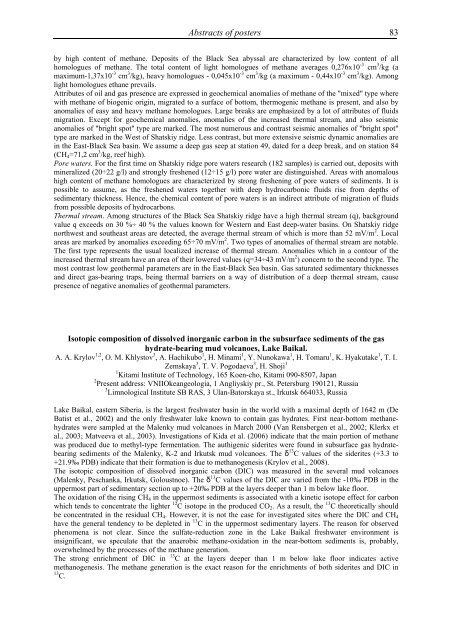Ninth international conference on - Marum
Ninth international conference on - Marum
Ninth international conference on - Marum
Create successful ePaper yourself
Turn your PDF publications into a flip-book with our unique Google optimized e-Paper software.
Abstracts of posters 83<br />
by high c<strong>on</strong>tent of methane. Deposits of the Black Sea abyssal are characterized by low c<strong>on</strong>tent of all<br />
homologues of methane. The total c<strong>on</strong>tent of light homologues of methane averages 0,276x10 -3 cm 3 /kg (a<br />
maximum-1,37x10 -3 cm 3 /kg), heavy homologues - 0,045x10 -3 cm 3 /kg (a maximum - 0,44x10 -3 cm 3 /kg). Am<strong>on</strong>g<br />
light homologues ethane prevails.<br />
Attributes of oil and gas presence are expressed in geochemical anomalies of methane of the "mixed" type where<br />
with methane of biogenic origin, migrated to a surface of bottom, thermogenic methane is present, and also by<br />
anomalies of easy and heavy methane homologues. Large breaks are emphasized by a lot of attributes of fluids<br />
migrati<strong>on</strong>. Except for geochemical anomalies, anomalies of the increased thermal stream, and also seismic<br />
anomalies of "bright spot" type are marked. The most numerous and c<strong>on</strong>trast seismic anomalies of "bright spot"<br />
type are marked in the West of Shatskiy ridge. Less c<strong>on</strong>trast, but more extensive seismic dynamic anomalies are<br />
in the East-Black Sea basin. We assume a deep gas seep at stati<strong>on</strong> 49, dated for a deep break, and <strong>on</strong> stati<strong>on</strong> 84<br />
(CH4=71,2 cm 3 /kg, reef high).<br />
Pore waters. For the first time <strong>on</strong> Shatskiy ridge pore waters research (182 samples) is carried out, deposits with<br />
mineralized (20÷22 g/l) and str<strong>on</strong>gly freshened (12÷15 g/l) pore water are distinguished. Areas with anomalous<br />
high c<strong>on</strong>tent of methane homologues are characterized by str<strong>on</strong>g freshening of pore waters of sediments. It is<br />
possible to assume, as the freshened waters together with deep hydrocarb<strong>on</strong>ic fluids rise from depths of<br />
sedimentary thickness. Hence, the chemical c<strong>on</strong>tent of pore waters is an indirect attribute of migrati<strong>on</strong> of fluids<br />
from possible deposits of hydrocarb<strong>on</strong>s.<br />
Thermal stream. Am<strong>on</strong>g structures of the Black Sea Shatskiy ridge have a high thermal stream (q), background<br />
value q exceeds <strong>on</strong> 30 %÷ 40 % the values known for Western and East deep-water basins. On Shatskiy ridge<br />
northwest and southeast areas are detected, the average thermal stream of which is more than 52 mV/m 2 . Local<br />
areas are marked by anomalies exceeding 65÷70 mV/m 2 . Two types of anomalies of thermal stream are notable.<br />
The first type represents the usual localized increase of thermal stream. Anomalies which in a c<strong>on</strong>tour of the<br />
increased thermal stream have an area of their lowered values (q=34÷43 mV/m 2 ) c<strong>on</strong>cern to the sec<strong>on</strong>d type. The<br />
most c<strong>on</strong>trast low geothermal parameters are in the East-Black Sea basin. Gas saturated sedimentary thicknesses<br />
and direct gas-bearing traps, being thermal barriers <strong>on</strong> a way of distributi<strong>on</strong> of a deep thermal stream, cause<br />
presence of negative anomalies of geothermal parameters.<br />
Isotopic compositi<strong>on</strong> of dissolved inorganic carb<strong>on</strong> in the subsurface sediments of the gas<br />
hydrate-bearing mud volcanoes, Lake Baikal.<br />
A. A. Krylov 1,2 , O. M. Khlystov 3 , A. Hachikubo 1 , H. Minami 1 , Y. Nunokawa 1 , H. Tomaru 1 , K. Hyakutake 1 , T. I.<br />
Zemskaya 3 , T. V. Pogodaeva 3 , H. Shoji 1<br />
1 Kitami Institute of Technology, 165 Koen-cho, Kitami 090-8507, Japan<br />
2 Present address: VNIIOkeangeologia, 1 Angliyskiy pr., St. Petersburg 190121, Russia<br />
3 Limnological Institute SB RAS, 3 Ulan-Batorskaya st., Irkutsk 664033, Russia<br />
Lake Baikal, eastern Siberia, is the largest freshwater basin in the world with a maximal depth of 1642 m (De<br />
Batist et al., 2002) and the <strong>on</strong>ly freshwater lake known to c<strong>on</strong>tain gas hydrates. First near-bottom methanehydrates<br />
were sampled at the Malenky mud volcanoes in March 2000 (Van Rensbergen et al., 2002; Klerkx et<br />
al., 2003; Matveeva et al., 2003). Investigati<strong>on</strong>s of Kida et al. (2006) indicate that the main porti<strong>on</strong> of methane<br />
was produced due to methyl-type fermentati<strong>on</strong>. The authigenic siderites were found in subsurface gas hydratebearing<br />
sediments of the Malenky, K-2 and Irkutsk mud volcanoes. The δ 13 C values of the siderites (+3.3 to<br />
+21.9‰ PDB) indicate that their formati<strong>on</strong> is due to methanogenesis (Krylov et al., 2008).<br />
The isotopic compositi<strong>on</strong> of dissolved inorganic carb<strong>on</strong> (DIC) was measured in the several mud volcanoes<br />
(Malenky, Peschanka, Irkutsk, Goloustnoe). The δ 13 C values of the DIC are varied from the -10‰ PDB in the<br />
uppermost part of sedimentary secti<strong>on</strong> up to +20‰ PDB at the layers deeper than 1 m below lake floor.<br />
The oxidati<strong>on</strong> of the rising CH4 in the uppermost sediments is associated with a kinetic isotope effect for carb<strong>on</strong><br />
which tends to c<strong>on</strong>centrate the lighter 12 C isotope in the produced CO2. As a result, the 13 C theoretically should<br />
be c<strong>on</strong>centrated in the residual CH4. However, it is not the case for investigated sites where the DIC and CH4<br />
have the general tendency to be depleted in 13 C in the uppermost sedimentary layers. The reas<strong>on</strong> for observed<br />
phenomena is not clear. Since the sulfate-reducti<strong>on</strong> z<strong>on</strong>e in the Lake Baikal freshwater envir<strong>on</strong>ment is<br />
insignificant, we speculate that the anaerobic methane-oxidati<strong>on</strong> in the near-bottom sediments is, probably,<br />
overwhelmed by the processes of the methane generati<strong>on</strong>.<br />
The str<strong>on</strong>g enrichment of DIC in 13 C at the layers deeper than 1 m below lake floor indicates active<br />
methanogenesis. The methane generati<strong>on</strong> is the exact reas<strong>on</strong> for the enrichments of both siderites and DIC in<br />
13 C.














